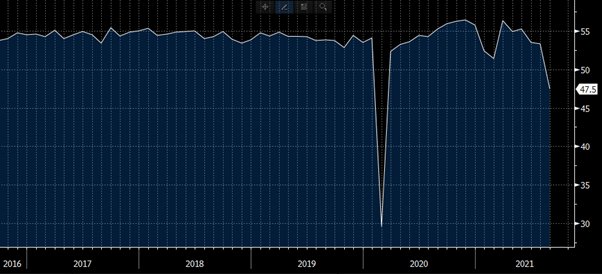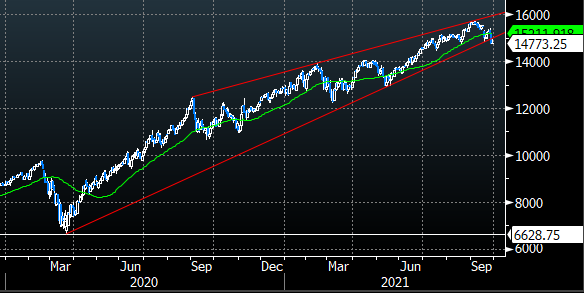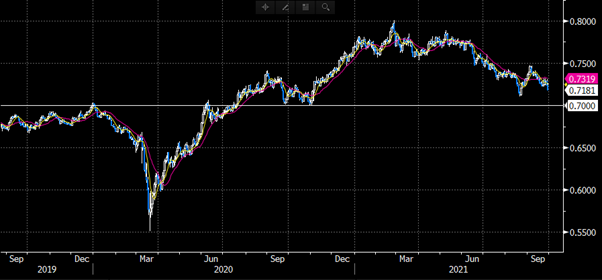
China has been rocked by a power supply crisis that has turned critical in recent days.
With rolling blackouts now reaching Shanghai and Beijing, and entire power grids threatened, analysts are slashing economic growth forecasts for the year.
16 out of 31 provincial jurisdictions have enacted electricity rationing measures in the last month affecting both households and the nation’s industrial sector, and further restricting the already struggling global supply chain.
Citibank have already cut their 2022 China GDP forecast to 4.9% from 5.5% based on the expected spill over from the managed restructuring of Evergrande. This will further weigh on China’s GDP forecasts and the subsequent effect this has on global growth.
After the Chinese Communist Parties recent clampdowns on technology companies, private education, and real estate, and with economic growth in China slowing, this power supply crisis is clearly a troubling development.
Related articles: How will the Markets Respond to a more Hawkish FOMC?
The reason for the electricity shortfall is the lower output from coal fired plants struggling with the sharp increase in coal prices. In fact, the price of Newcastle Coal has risen 300% in the last year (chart below), so with fixed electricity prices in China, coal fired electricity production has become largely unprofitable.
Also, President Xi Jinping has pledged a peak of carbon dioxide emissions by 2030 and carbon neutrality by 2060. Local governments subsequent ‘green’ efforts have also factored heavily in these shortages.

Chart 1. ICE Newcastle Coal Futures price has risen over 300% in the last 12 months as commodity prices spiral higher. (Source: Bloomberg)
In China, thermal power generation has risen 14% in the past 12 months while coal production has only risen 4.4%, and inventories at six major Chinese power producers are down 31.5% from last year.
To make matters worse, global coal supplies have fallen with production hampered by COVID mine shutdowns, labor shortages, and heavy rain particularly in Columbia and Indonesia.
China, refusing to import Australian coal due to a political dispute, is clearly paying more aggressively for the natural resource, outbidding other countries for supply of the finite commodity.
The energy crisis is not unique to China of course with natural gas prices at record levels in Europe heading into winter season, and 3 more energy companies going out of business yesterday (the 29th of September) in the UK (Enstroga, Igloo Energyt, and Symbio Energy).
Because of these gas prices, higher coal demand is expected through winter with lower renewables output and stockpiles of coal at India’s massive number of coal plants is also running dangerously low.
“Asia doesn’t have enough coal,” said Saad Rahim, Chief Economist at major commodity trading house Trafigura Group.

Chart 2. China's economy is already in a fragile state with both services PMI (above) and Caixin manufacturing PMI (Purchasing Managers Indices) back in sub-50 contraction levels. (Source: Bloomberg)
The rising energy prices globally of course lead to knock-on inflationary pressures in the supply chain.
This is exacerbated by other supply chain constraints driving prices higher, such as lock downs, port blockages and container shortages.
The commodity race higher was initially led by lumber, then energy prices, and in the last few weeks magnesium, silicon and uranium amongst others have joined the race upwards.
Supply chains are being upended not only through logistics (the Baltic dry index is at 13-year highs), but also shutdowns and lack of components (particularly microchips and the automotive industry).
Commodity trading companies are calling force majeure on contracts due to scarcity. The central bankers are now realizing inflation is not transitory, hence the more hawkish rhetoric in recent weeks. In fact, Germany’s import price index was released yesterday and is up an astonishing 16.5% YTD, and Spain’s producer prices rose 18% YoY.
The supply chain is increasingly undergoing a domino effect.
The CCP has already injected liquidity into the financial system this week to shore up confidence after the collapse in real estate bonds and knock-on effects from the Evergrande ‘crisis’.
They have also instructed state-backed firms to takeover Evergrande projects to help suppress the spread of financial distress through the rest of the economy.
Evergrande were again downgraded today by the rating agency Fitch to C from CCC. The ruling party has ordered coal miners to raise production to full capacity, and ordered energy companies to secure winter coal, electricity and oil supplies ‘at all costs’.
But ultimately, they will have to take the unpopular decision to raise electricity prices just as economic growth is slowing and property prices are falling (property accounts for over 80% of consumers wealth in China).
“This is the beginning of the end of China’s growth model as we know it,” said Leland Miller, the Chief Executive Officer of the consulting firm China Beige Book.

Chart 3. The Nasdaq has broken a key support trendline and the 50-day moving average, both key risk management levels. A top increasingly looks to be in place (Source: Bloomberg)

Chart 4. AUDUSD – the Australian dollar trending lower against the U.S. dollar and targeting the 0.7000 level, hamstring by local lockdowns, China trade disputes, global growth, concerns regarding domestic property prices and the hawkish Federal Reserve. A break below 0.7000 could see an aggressive move lower in the weeks ahead.
The more hawkish Federal Reserve last week has driven both global yields and the U.S. dollar to its highest level in a year.
These headwinds added to already slowing global growth, a China slowdown, painfully high (and not transitory) inflation, on-going lockdowns, and debt ceiling shenanigans on Capitol Hill.
This is making investors increasingly nervous, and economists are starting to use the dreaded ‘stagflation’ headline. U.S. equities have just had their worst week in over a year and asset prices are looking much more uncertain by the day.
Again, central bankers appear trapped, as their actions now have bigger and bigger consequences.







